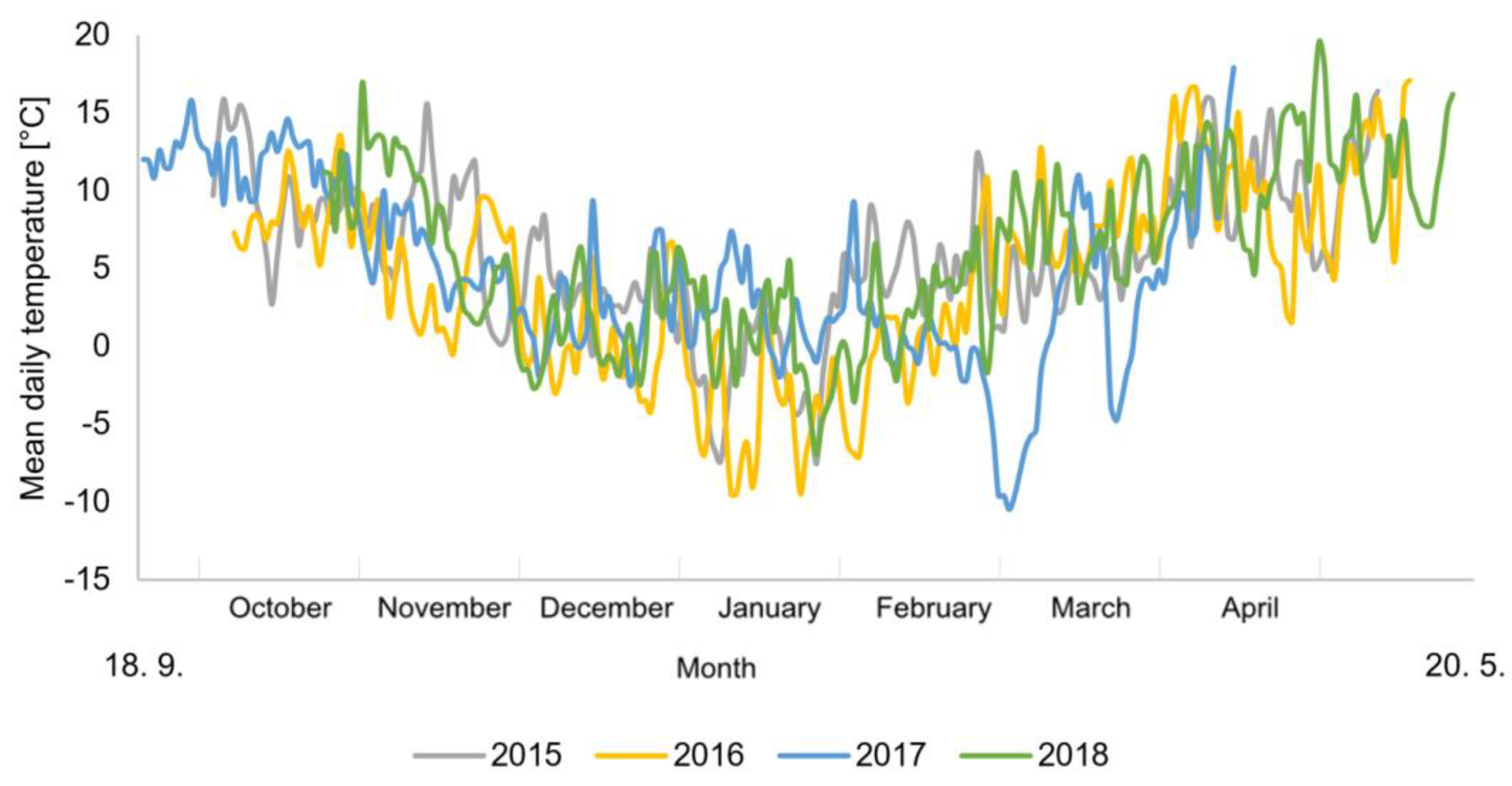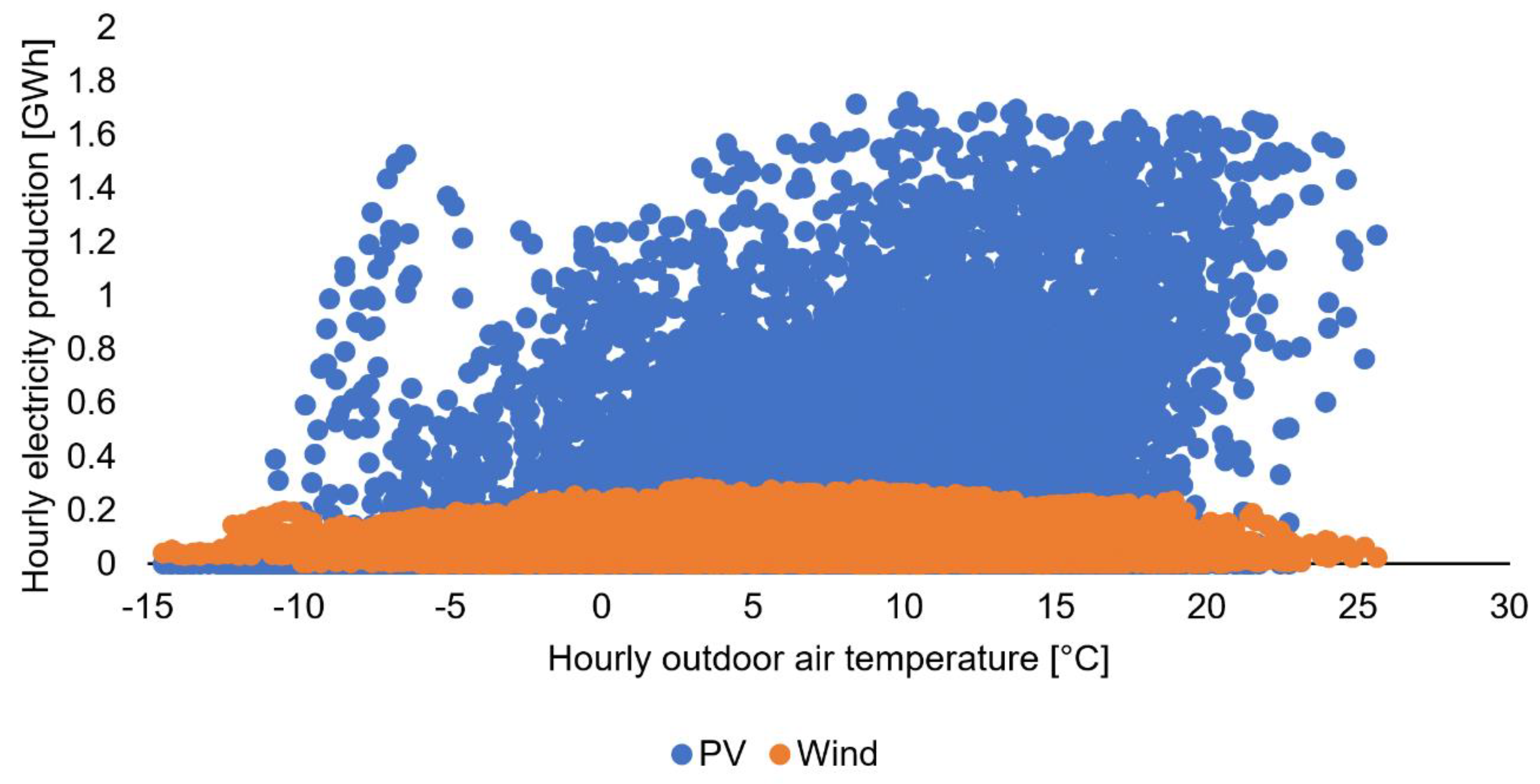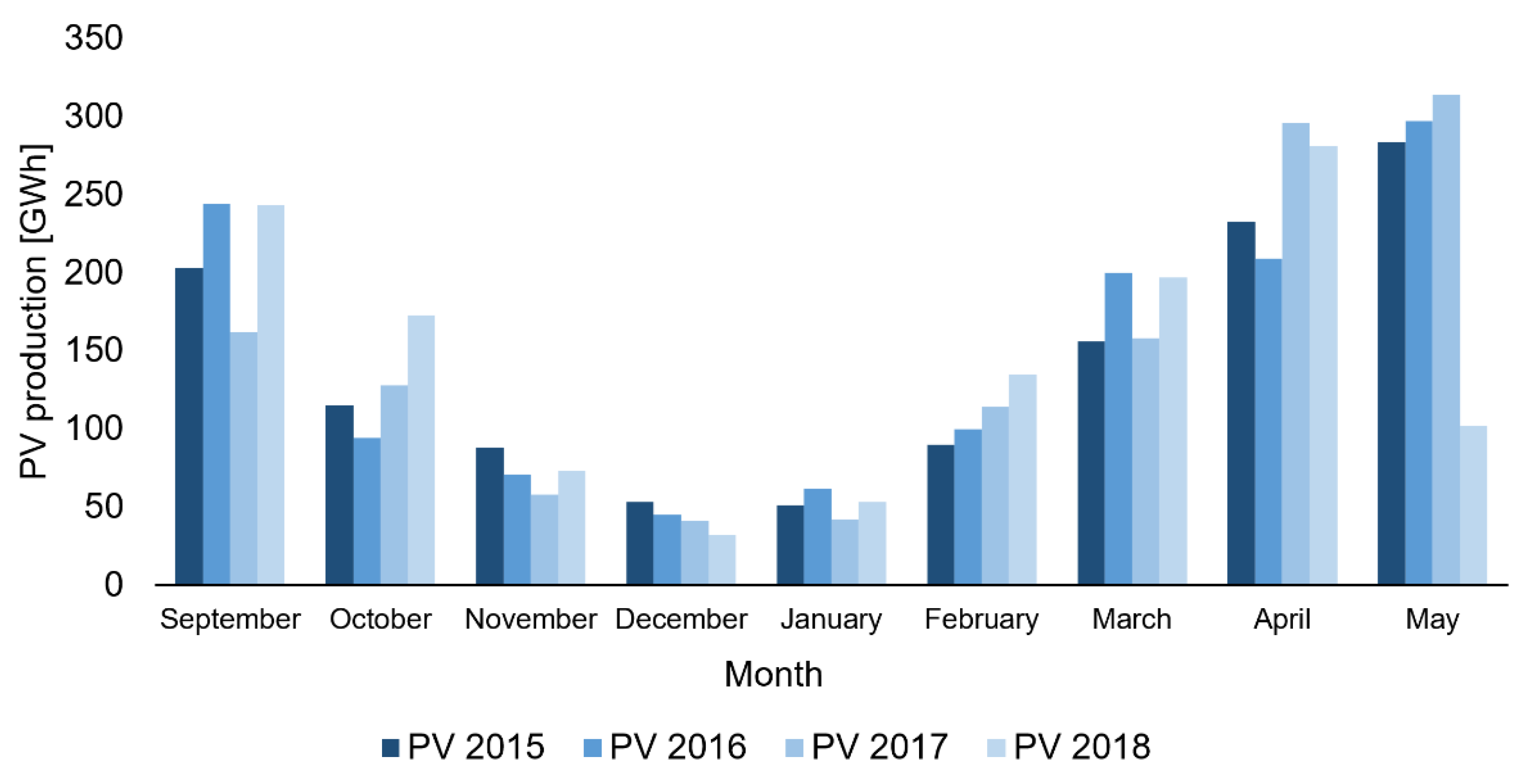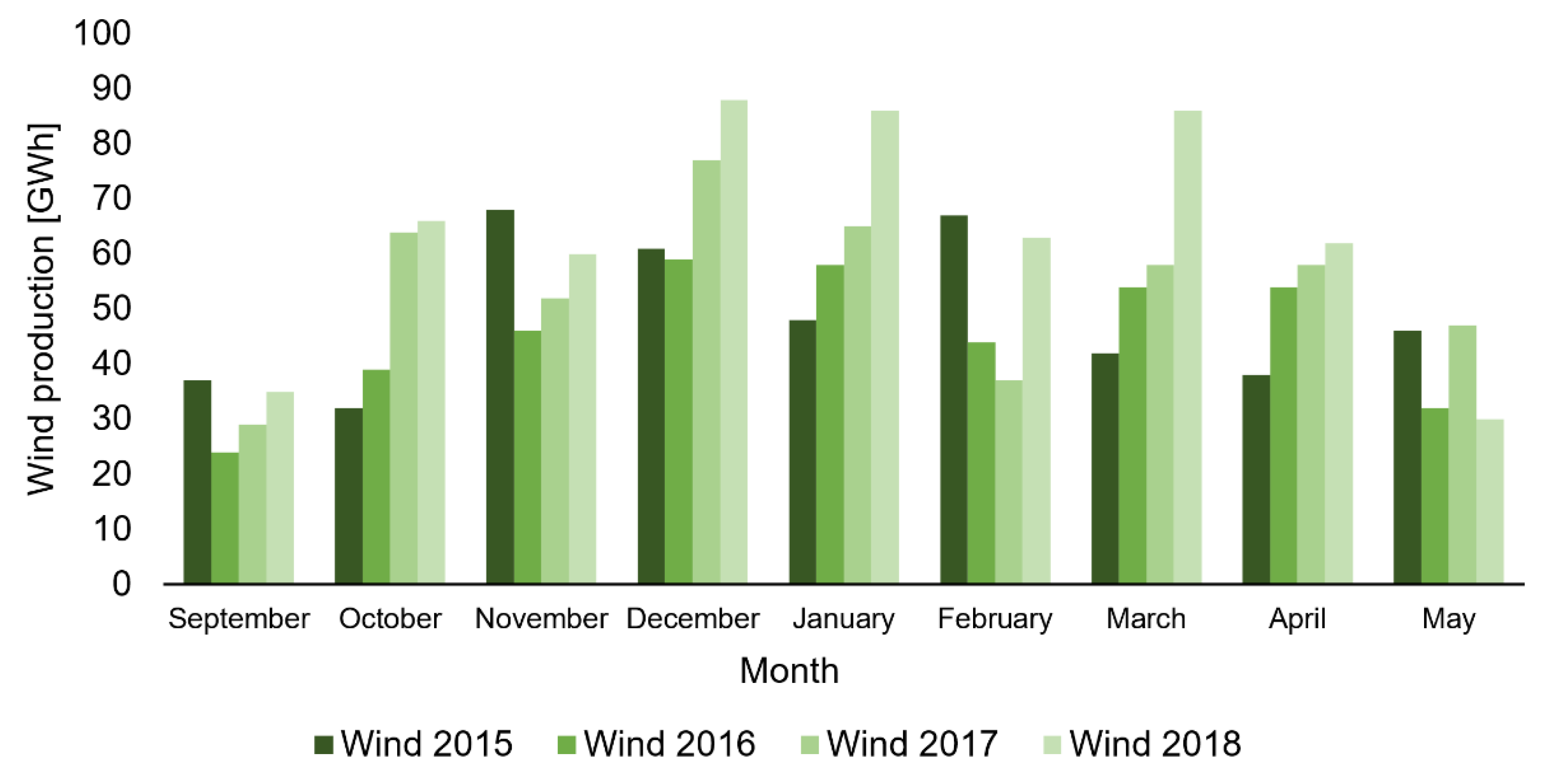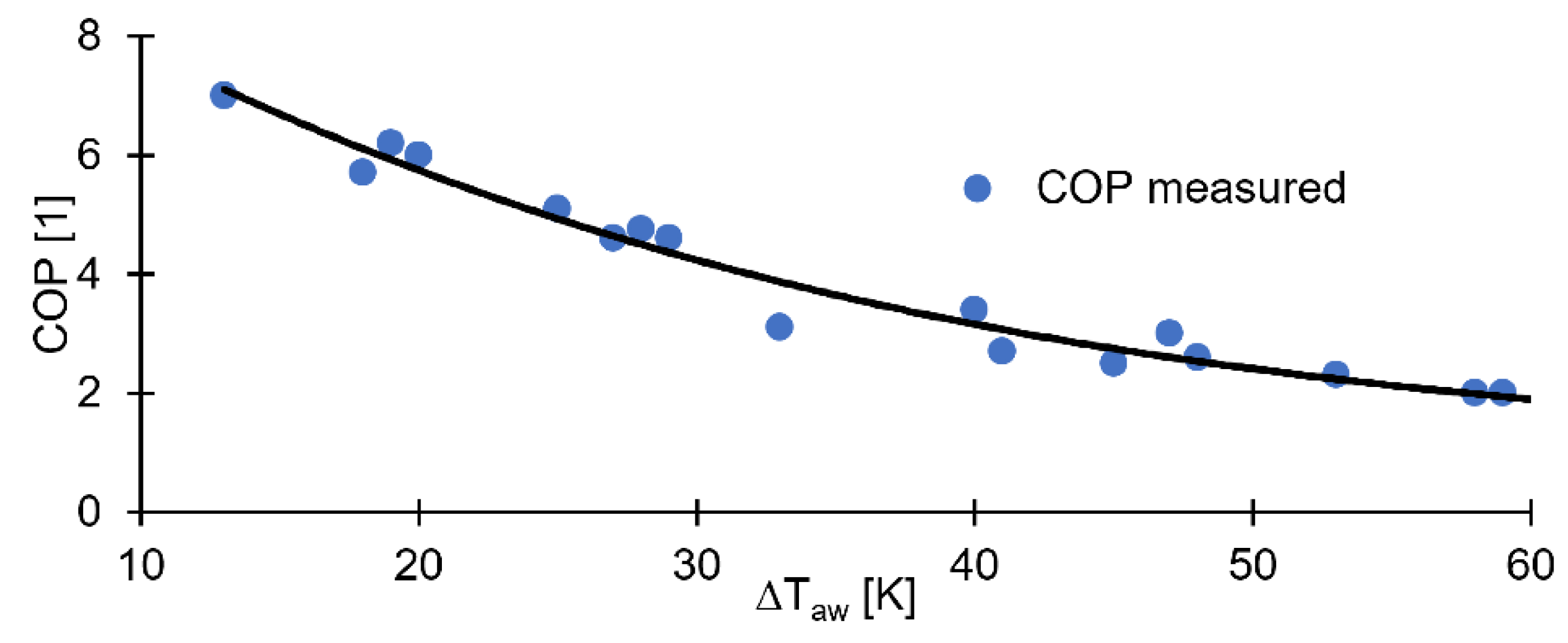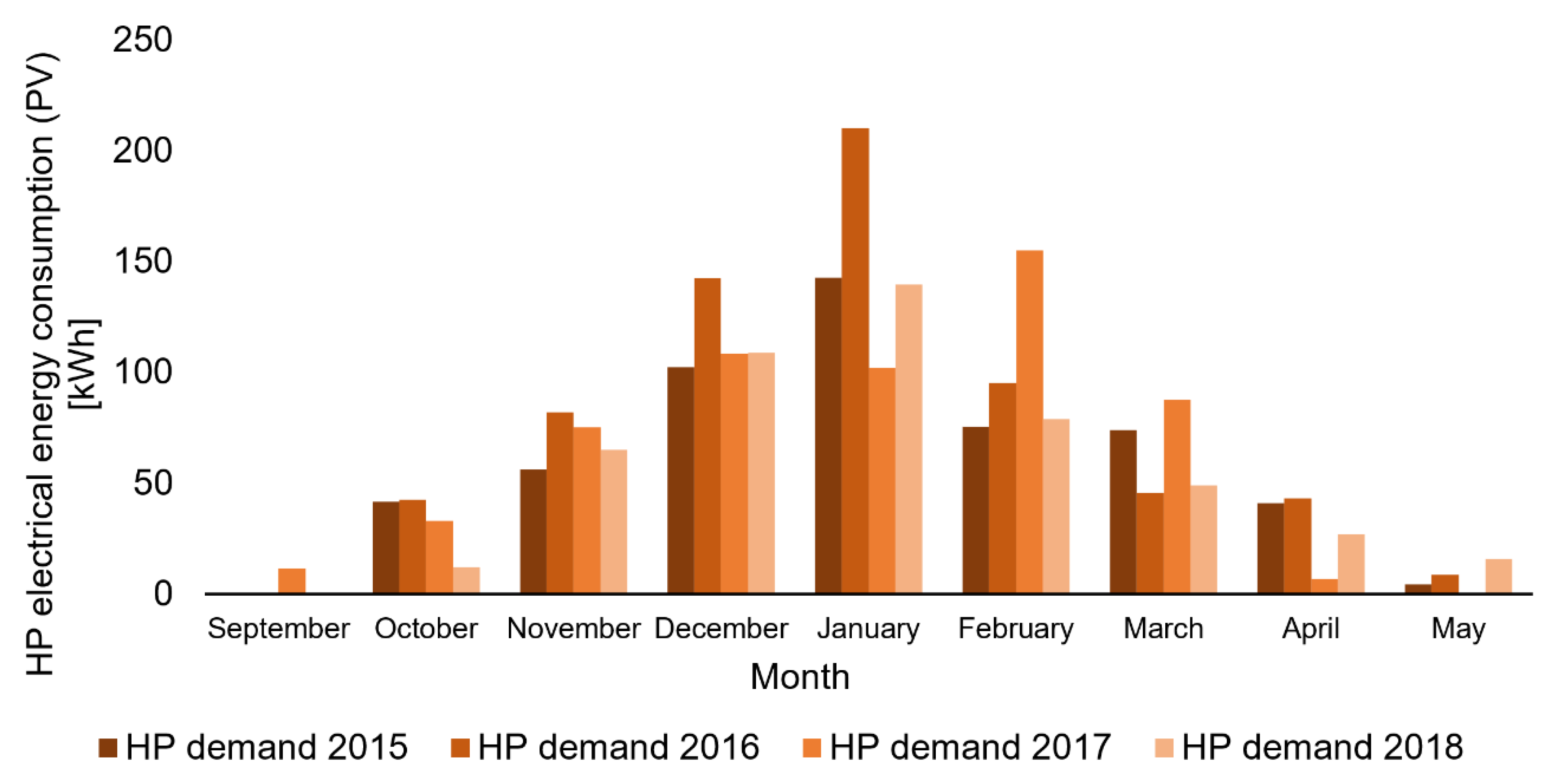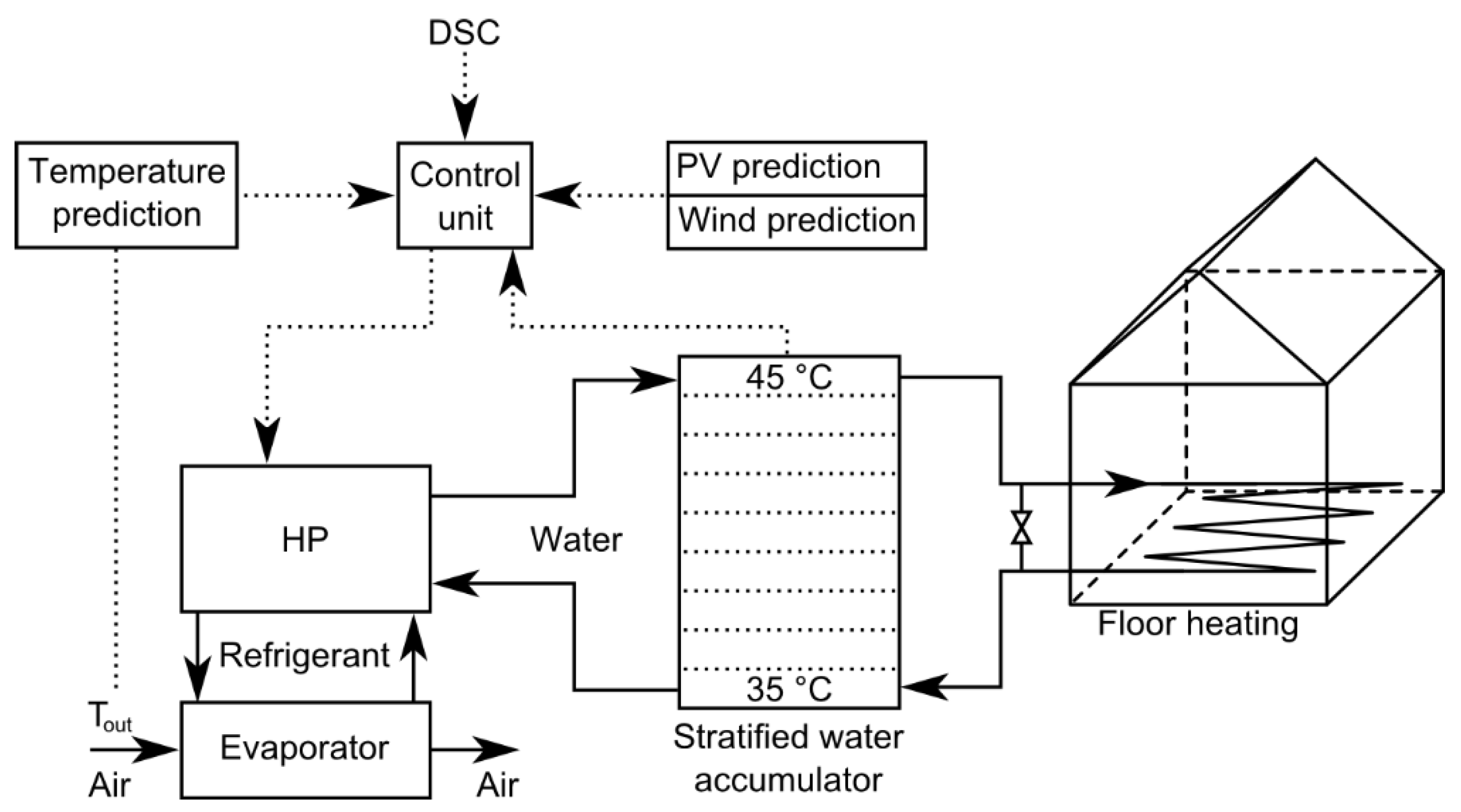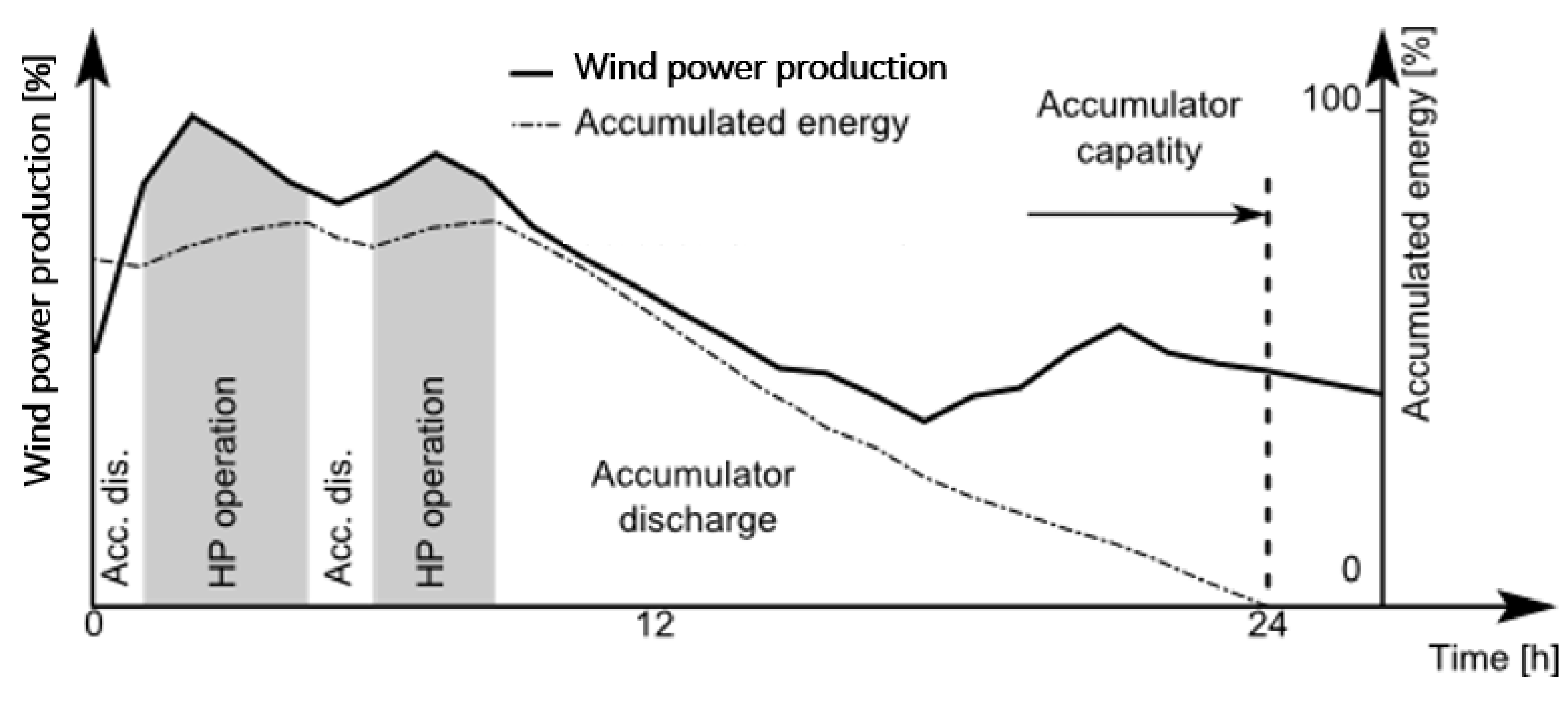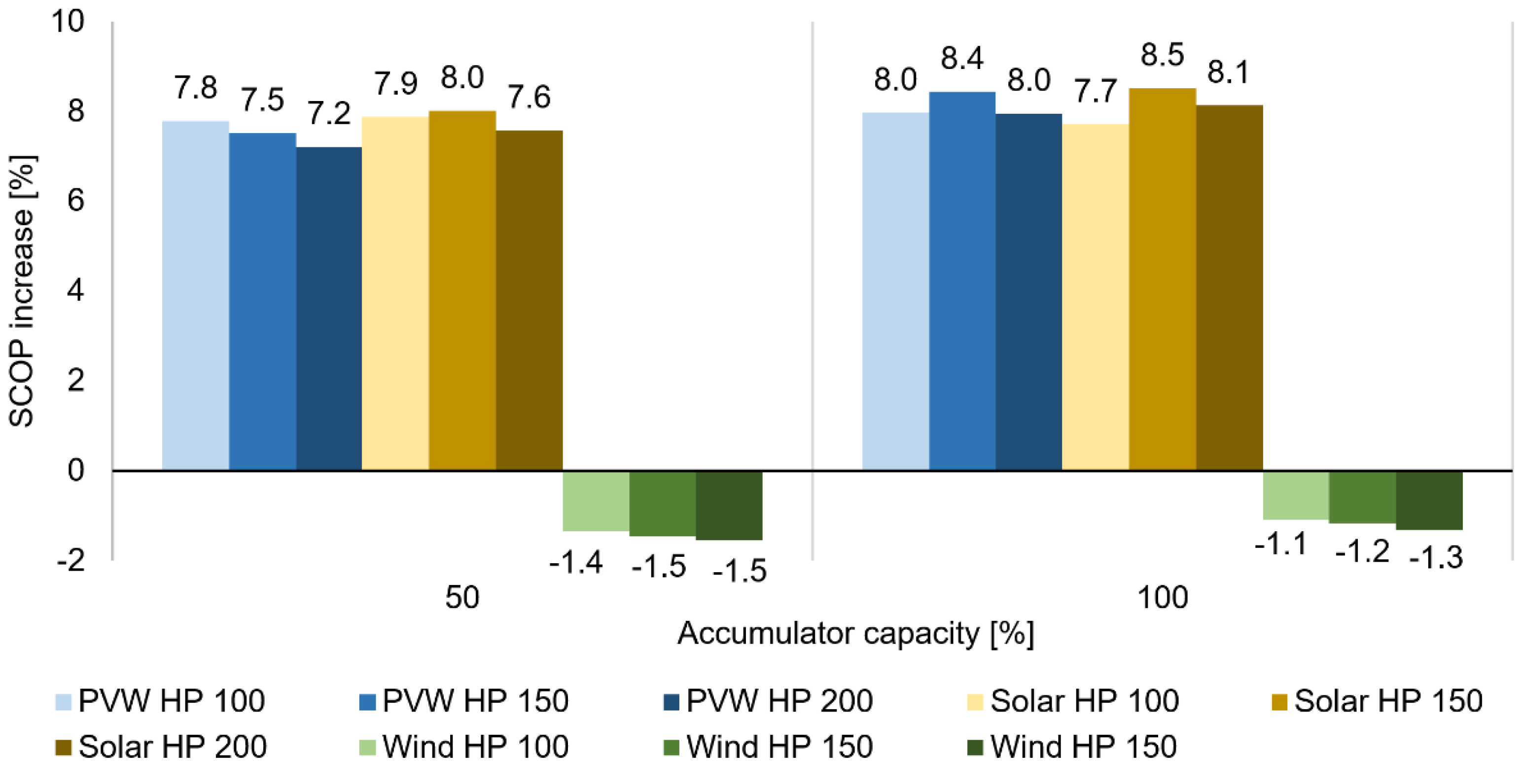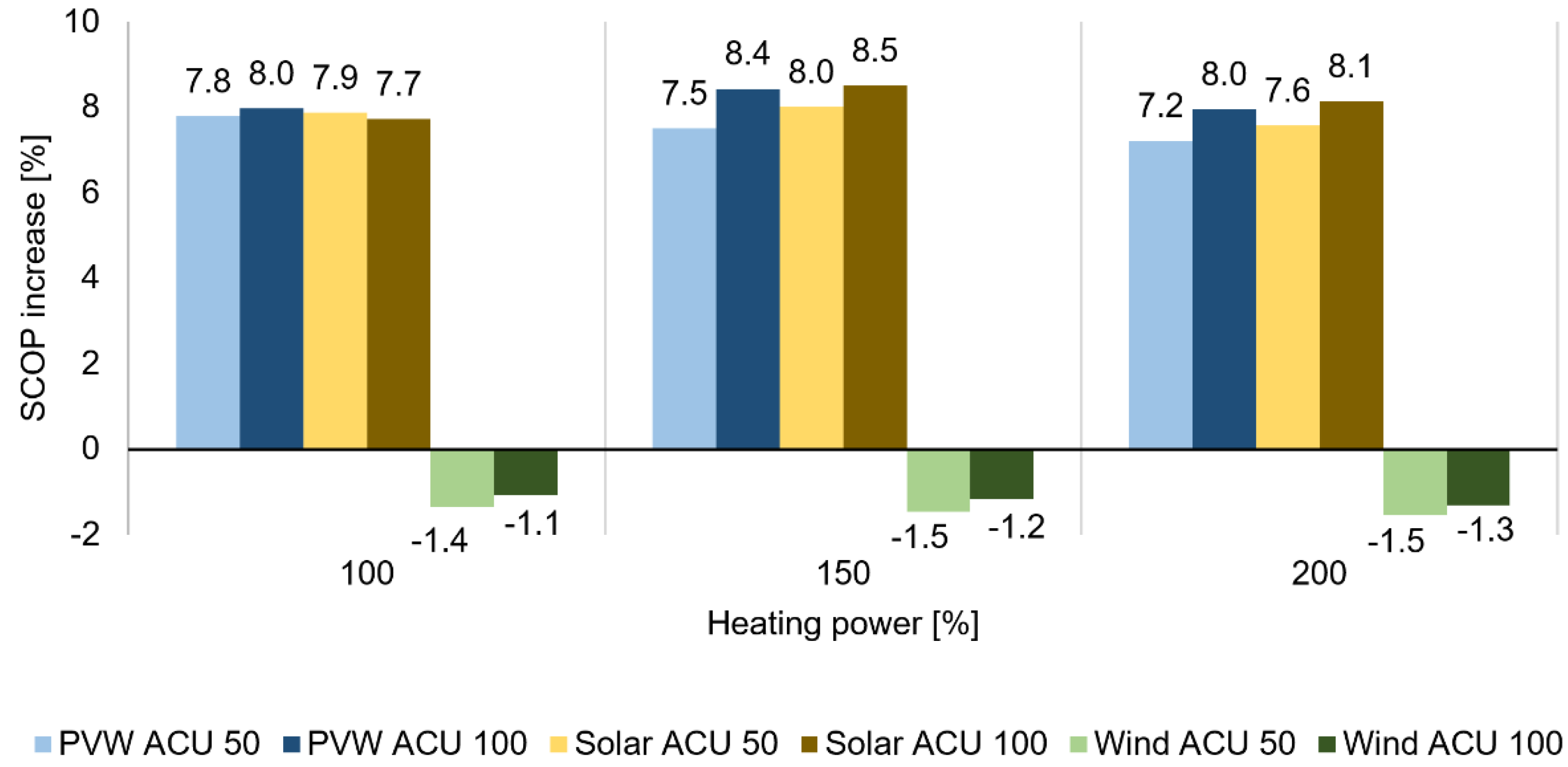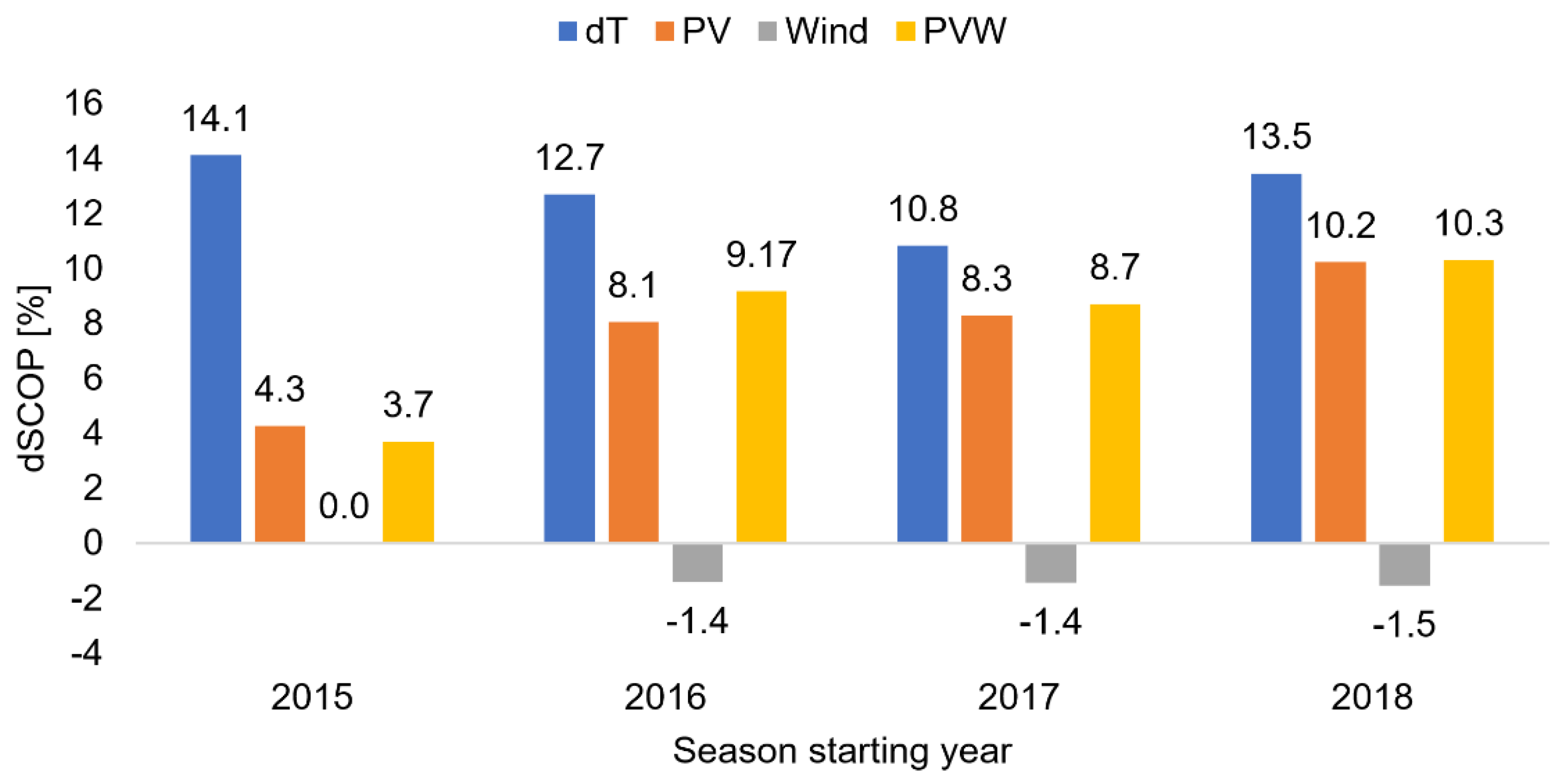1. Introduction
The current worldwide trend is to increase the production of electrical energy from renewable energy sources (RES). In Europe, this is usually achieved by increasing the production of electrical energy from sources with unstable production, such as from wind and solar power plants. The European Union (EU) is taking active steps to decarbonise the power industry, which supports an increase in the proportion of RES, e.g. “Roadmap for moving to a competitive low carbon economy in 2050” [
1]. Fluctuations in electrical energy production from RES are compensated within the distribution system with the flexibility of other sources, especially hydroelectric power plants and gas power plants. Despite the increasing number of various types of accumulators installed, the accumulation of electrical energy in the distribution system is not yet organized satisfactorily. The distribution system must currently use all of the available and economically acceptable technologies to compensate for the differences between the immediate production and consumption of electrical energy.
Another option with considerable potential is the application of demand-side management (DSM) of electricity to compensate for the mismatch between the production and consumption of electrical energy. DSM focuses on the control of regularly used electrical appliances. The appliance must allow for unplanned switching on and off without decreasing user comfort or compromising the safety requirements. In this context, the possibilities of using DSM in industrial applications are assessed. A considerable potential for the use of DSM may be found in the residential sector, namely by remote control of domestic heat pumps.
Energy consumption in the residential sector of EU countries corresponded to 25.4% of the total energy consumption in 2016 [
2]. A significant portion of energy consumption is involved in hot water preparation and space heating. The average heating demand of residential space in EU countries is 160 kWh·m
2·y
−1 [
3]. The European Heat Pump Association (EHPA) report shows that 1.25 million heat pumps (HPs) were sold in 2018 in the European market, which means an increase of 12% compared to 2017 [
4]. Almost 10% of all residential houses in the EU currently use HPs as a source of heat energy [
4].
The prediction of market developments in this field speaks about a progressive increase in installations in the coming years [
4]. The previous studies show that Air-water heat pump (AWHP) installation at the individual level should give higher global performance than large scale installation (e.g., building installation, district installation) thanks to the system simplicity and minimal heat loss [
5]. The number of HP installations is currently increasing in the area of heat recovery systems too, e.g. small-scale heat recovery from sewage water or city scale waste heat recovery in a sustainable city context [
6]. Another prospective use of HPs is associated with increasing the capacity of large-scale heat storage tanks. The number of these installations will be related to the development of large capacity thermal storages in heating networks. In this context, HPs constitute one of the promising appliances for DSM [
7] due to significant number of new installations in the coming years. The characteristic features of this appliance include its considerable electricity consumption and the significant amount of remote control. AWHPs represent a heat production technology that has had the most dynamic development throughout the EU [
8]. The working parameters of HPs have been improving in the last few years [
9]. Using inverter-driven compressors that enable the efficient functioning of HPs under full and partial loads has contributed to this trend. This is important for planning smooth changes in the output or consumption of an HP.
HPs enjoy considerable popularity in the Czech Republic. Number of installations have been increasing progressively in recent years, as shows
Figure 1.
A simple version of the DSM in the form of ripple control has been used in the Czech Republic for decades. The ripple control has basically two functions. First, it is used for switching between tariffs on the consumption (demand) side. The tariffs in this context refer to electricity prices. In the time periods of high demand for electricity (usually during the day), the billing prices of electricity are higher than during the time periods of lower demand for electricity (usually at night). Electrical appliances, whose operation is permitted during the high demand periods, can be operated without restrictions, but at the penalty of higher electricity prices. The billing price of electricity during the high demand periods is the only incentive for the consumers to shift the operation of some of these appliances (dish washers, washing machines, cooking ovens, clothes iron, etc.) to the time periods of lower demand. The second function of the ripple control is the outright blocking of the operation of certain electrical appliances during certain parts of the high demand time periods. The typical appliances in this category are electric space heating systems, electric domestic hot water systems and heat pumps.
The effective implementation of DSM to heat pumps requires a complex approach. A significant component in this complex approach is energy storage. As the heat pumps deliver energy in the form of heat, thermal energy storage is the most feasible way of energy storage in this respect. The Czech Republic has implemented several incentives to decarbonise space heating of residential buildings. The main focus is on the replacement of coal with less polluting fuels. This policy translated into increasing number of heat pump installations as can be seen in
Figure 1. However, as of now, the installation of thermal energy storage with a heat pump is neither required nor financially supported (incentivised). There are several ways this kind of incentives could be provided. The direct financial subsidies do not always produce the best effect. A better option might be flexible billing prices of electricity that would incentivize installation of energy storage in order to take advantage of lower prices of electricity. On the other hand, installations of heat pumps with thermal energy storage (usually water storage tanks) are relatively common even without incentives. That makes heat pumps a promising category for DSM.
This study focuses on comparing several scenarios of predictive AWHP control, preferring operation in periods of peak electrical energy production from wind and photovoltaic (PV) power plants. For the evaluation, historical records of the outdoor air temperature in the city of Brno from 2015 to 2018 are used. Brno lies in the southeast part of the Czech Republic (CZ) (GPS: 49.2065331° N, 16.5923336° E). The evaluation also uses historical records of the electricity produced from renewable sources in the Czech Republic from the same period. The aim of comparing the different predictive control scenarios is the quantification of the impact of their use on the real seasonal coefficient of performance (SCOP) of the AWHPs. The results obtained for operation with predictive control are compared to AWHP operation parameters without predictive control. The study also presents the results of parametric studies evaluating the influence of heat accumulator size and AWHP heat output on the resulting SCOP. The results can be used to assess the potential of AWHP control for electrical energy consumption control in periods of peak electrical energy production from RES. Furthermore, the results can be used to consider further development of using RES for covering the electricity demand of AWHPs. All the conclusions reached are relevant for the conditions existing in the Czech Republic and are based on the real data from 2015 to 2018. However, the developed calculation procedure is applicable in other similar climates. Some general outcomes, such as preferable operation of air-to-water heat pumps during daytime, when the PV power plants produce electricity, and at the same time, the outdoor air temperature is higher, are valid in most climates and situations.
The target of this study is to present possible utilization of AWHPs as a suitable DSM remote control of electrical appliances with prior operation in periods of peak power production from RES.
2. Electrical Energy Production in the Czech Republic
Meteorological conditions and electricity production from RES are parameters relating to a specific location and the energy infrastructure of a specific country. This study was carried out with the specific conditions of the Czech Republic in 2018. The results of the study may not be generalised and may only be very cautiously compared with the conditions in other similar locations.
The Czech Republic is a landlocked country located in the centre of Europe. As of January 1, 2017, the population of the Czech Republic was 10.6 million inhabitants, the area was 78,870 km
2 and the population density was about 134 inhabitants/km
2 [
11]. In the Czech Republic, nuclear and steam power plants produce 85 % of the electrical energy. As seen in
Figure 1, RES produced 11% of electrical energy in 2018.
The latest available report on the operation of the Czech electrical grid [
12] provides the following performance data. The total electrical energy production and consumption in the Czech Republic is constantly increasing, although in the last few years the rate of increase has been slowing. The total (gross) electrical energy production in the Czech Republic in 2018 was 88 TWh, while the total consumption was 73.9 TWh. It was the highest annual electrical energy consumption to be recorded. The Czech Republic is also a net exporter of electrical energy and the net export reached 13.9 TWh (25.5 TWh export and 11.6 TWh import) in 2018. The total electricity production from RES was 9.4 TWh in 2018 and the share of RES in the total electrical energy consumption in the Czech Republic was 12.7%. The total electrical energy production from RES has practically unchanged in the last 4 years.
The installed capacity of PV power plants in 2018 was 2.057 GW and this capacity has not changed since 2015 due to low support for new PV power plants. The average capacity factor of PV power plants in 2018 was 0.13. However, there has been a gradual increase in the installed capacity and electricity production in wind power plants. The total installed capacity in 2018 was 316.2 MW and the capacity factor was 0.22. The installed capacity of wind and PV power plants is shown in
Table 1.
4. Results and Discussion
The modifications to predictive control were assessed by the parametric study of two different capacities of the heat accumulator (thermal storage tank). In the basic case (ACU 100), the overall heat storage capacity of the accumulator corresponded to a 24-h heat demand of the model building at the outdoor temperature of −12 °C. As the heat loss of the model building was 1 kW at −12 °C, the other accumulator (ACU 50) had the overall heat storage.
Another part of the parametric study focused on testing the impact of the heat output of the model HP. The heat output tested was 50%, 100% and 200%. The heat output of 100% corresponds to the heat output of 1 kW, including the calculated heat loss of the model building. The results obtained using predictive control of the AWHP were compared to the AWHP operation without predictive control, i.e., controlled only by the instantaneous heat demand without using a heat accumulator. The SCOP of the basic scenario was identified as 3.2. This value was used as basis for all following expression of relative changes of SCOP in particular scenarios.
The results of the parametric study are summarized in
Figure 10. The graph shows the relative increase or decrease in SCOP when predictive control is applied in relation to the basic condition.
The relations presented in
Figure 10 and
Figure 11 show that if the AWHP operation is preferred during the periods of production from PV power plants, there is an increase in SCOP of approximately 8%. This increase is related to the outdoor air temperature at the time of production from PV power plants. The daytime periods with an intensive solar contribution are characterized by the highest day air temperatures. Each curve related to PV production was obtained for an AWHP with different heat output, namely 100%, 150% and 200%. On the other hand, significant electricity production from wind power plants is most often observed during cold days and during parts of the day with a below-average temperature (night). The decrease in SCOP when the AWHP operation is preferred during periods of the highest production from wind power plants corresponds to approximately 1.4% compared to the condition without predictive control.
One of the limiting aspects of this approach is the size of the thermal storage vessel. To make sure the 1 kW heat losses are fully covered the accumulator needs 24 kWh thermal energy capacity. When considering 10 °C temperature difference between the higher and lower temperature of the space heating water with considered thermal capacity 4.18 kJ·kg−1·K−1, the water volume is equal to 2067 l.
Increasing the size of the accumulator (
Figure 10) contributes to an increase in SCOP in all assessed modifications of predictive control; however, this increase is very small. The increase in the heat output of the AWHP (
Figure 11) does not follow a clear trend within the scope of the parameters tested when the operation based on PV production is preferred. During regulation control based on production from wind power plants, there is a slight decrease in SCOP when the AWHP heating power increases.
The results clearly show that what influences the SCOP value the most is the parameter that controls the preference of AWHP operation. Increasing the capacity of the heat accumulator and increasing the output of AWHP influences the SCOP value only slightly.
Having this knowledge, other modifications of predictive control preferring AWHP operation in the day periods were assessed, including: (i) highest temperature and (ii) production from any RES (PV and wind). The calculation results are presented in
Table 2. It presents relative change of SCOP compared to the AWHP operation without predictive control.
Figure 12 shows the results obtained for all the predictive control modifications tested. For all modifications of predictive control, the ACU 100% operation parameters and the heat output of 100% were assumed. The following were used as the predictive control parameters: outdoor temperature, PV power production, wind power production, and PV and wind power production combined. The results are presented as a relative increase or decrease of SCOP compared to the basic scenario without the use of predictive control. The highest relative increase in SCOP is achieved for the predictive control scenario ensuring AWHP operation in periods with the highest outside air temperature. In terms of the DSM concept, a relative increase in SCOP was achieved in the case of predictive control driven by the production of electricity from PV powerplants. This increase respects the fact that significant PV power plant production runs in periods with intense sunlight. At the same time, the highest outside air temperatures are achieved. In the case of the predictive control with wind power generation scenario, a relative decrease in SCOP was identified. This behaviour is because increased wind speeds occur mainly in periods with below-average outside air temperatures.
6. Conclusions
The study focused on comparing four modifications of predictive control used for operation control of an air-water heat pump (AWHP). The following variables were used as the predictive control parameters: outdoor temperature, PV power production, wind power production and PV and wind power production combined. The biggest increase in SCOP was found to be 14% and it was achieved when the AWHP operated during periods with the highest day temperature. This way of control is very promising due to its simplicity and easy feasibility. When the operation of the AWHP was controlled by the production from PV power plants, the maximum increase in SCOP was 10.25%. This SCOP increase is related to a good correlation between periods with intensive production from PV power plants and the highest day air temperature. Almost the same increase in SCOP of up to 10.33% was reached when the AWHP was controlled by the total production from PV and wind power plants. A decrease in SCOP only occurred in one case, which was when the AWHP operation was controlled only by production from wind power plants. In this case, the decrease in SCOP was 1.5%. All the values presented were compared against the heat pump SCOP without predictive control. The predictive control modifications were used in parametric studies monitoring the impact of the heat accumulator capacity and the heat output of the heat pump. These studies monitored predictive control modifications based on production from renewable energy sources. When the control was based on combined PV and wind power production, increasing the heat output of the pump showed no positive impact on the final SCOP value. Increasing the heat accumulator size enables longer storage of energy from the preferred periods of the heat pump operation. The testing of the modifications of predictive control showed that increasing the heat accumulator capacity causes an increase in the heat pump SCOP value. One of the limiting aspects of this approach is the size of the thermal storage vessel. To make sure the 1 kW heat loss is fully covered, the accumulator needs 24 kWh thermal energy capacity. When considering 10 °C temperature difference between the higher and lower temperature of the space heating water with considered thermal capacity 4.18 kJ·kg−1·K−1, the water volume is equal to 2067 l.
Further research should be focused on assessing the impact of different types of heat accumulators on the overall efficiency of the system. Furthermore, attention will should be focused on the possible improvement of the ripple control used today in the management of HPs.

